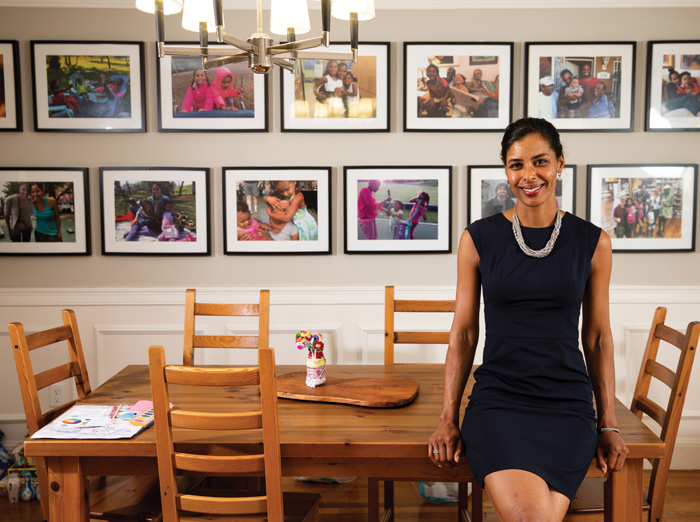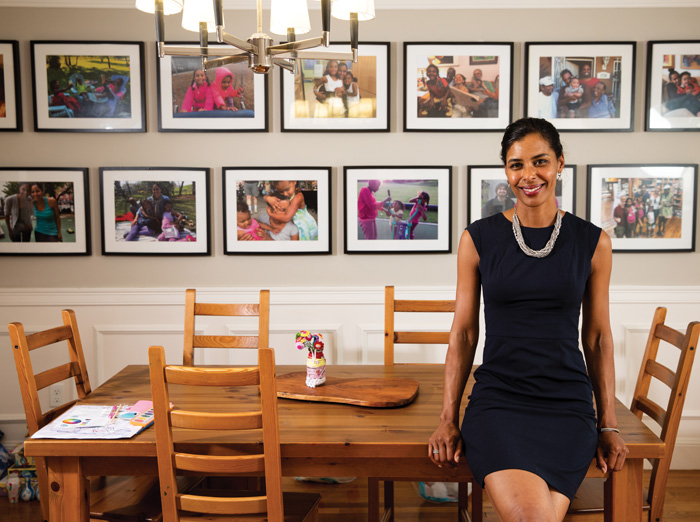
Keeping an Eye on the Nation’s Nutrition
In a new role at the USDA, an award-winning researcher and public policy expert is poised to break down barriers to nutrition security and health equity.
Article Content
Sara Bleich speaks from experience.
That is not only because she is a former professor of public health policy at Harvard and has authored more than 150 peer-reviewed publications—or even because she has served as a health policy advisor for two administrations. Bleich brings another important perspective to her current role as director of nutrition security and health equity for the U.S. Department of Agriculture’s (USDA) Food and Nutrition Service. As a child growing up in inner city Baltimore, she was the recipient of benefits from the very federal food assistance programs she is now charged with overseeing and improving.
Food Technology caught up with Bleich to get her perspective on a range of issues, including childhood obesity, the impact of the COVID-19 pandemic on food and nutrition security and equity, and the roles that government and the food industry can play in solving these challenges. Bleich also discussed her role in this fall’s historic White House Conference on Hunger, Nutrition, and Health, the first such event to be held in decades and one that has been designed to bring together diverse stakeholders to address the food security crisis and reduce the devastating impact of diet-related diseases.
Is yours a newly created position at USDA? What is your personal mission in this role?
It is new. I started in January 2022. My job is to execute against Secretary (Tom) Vilsack’s vision for nutrition security, which means access to affordable and nutritious food. My personal mission is to give back to the programs that gave me so much. As a kid, I received SNAP (Special Nutrition Assistance Program, formerly food stamps), as well as WIC (Supplemental Nutrition Program for Women, Infants and Children), and occasionally School Lunch. My mission is to strengthen the impact of these programs.
What is the difference between food insecurity and nutrition insecurity?
Food security is access at all times to enough food for an active, healthy life. Nutrition security means having consistent and equitable access to healthy, safe, and affordable food. Nutrition security builds on food security by recognizing we are not all maintaining an active, healthy lifestyle and takes an equity lens to all our efforts.
What’s keeping us from developing truly integrated systems solutions to issues such as food/nutrition security and the public health threat of diet-related diseases? Who needs to be talking/cooperating more?
One of the things that is keeping us from developing a truly integrated system is having leadership with that dedication in mind. Congress has now funded a White House Conference on Hunger, Nutrition, and Health. That will serve to bring together lots of ideas about how we think about these issues. To make a dent, to get everyone working together, we need an organizing entity that is going to hold people accountable and moving in the same direction. And there is a bit of a gap in that space.
Tell us about your role in the White House Conference on Hunger, Nutrition, and Health?
USDA has been working closely with the Domestic Policy Council at the White House on the Conference. We are excited to contribute to this important effort. I serve as one of two points of contact from the USDA, along with Kumar Chandran, on the White House Conference planning team. We have been blown away by the thoughtful contributions through the listening sessions, web-based sharing of ideas, and the various meetings to date we have had with stakeholders like IFT and a variety of individuals and organizations in the food science sector as we prepare for this second, historic conference.
One of the five pillars of the conference is “integrate nutrition and health,” which involves prioritizing the role of nutrition and food security in overall health. That seems as if it aligns closely with your areas of interest and focus. What conference outcome do you hope to see in this area?
We hope that all of the conference pillars contribute to our efforts at USDA on nutrition security, as it will take a comprehensive approach to end hunger, reduce diet-related diseases, and accelerate progress on health equity. For the pillar on integrating nutrition and health, our goal is that we can continue to help USDA lift up to further lean into nutrition security, as well as identify opportunities for us to work across the government and with key stakeholders like the food industry to really make this second, historic conference impactful for all Americans.
What do you see as the most important actions that could bring more equity across race, neighborhood, and socio-economic status to diet, nutrition, and obesity prevention?
One big thing would be maximizing participation in the federal nutrition programs. There are decades of research that show participation in the WIC program results in healthier births, reduced mortality, better infant feeding practices, more nutritious eating patterns, access to primary and preventive healthcare, reduced obesity risk, and even improved cognitive development and academic achievement. But only half the people eligible participate, despite a lot of outreach.
Similarly, SNAP has been shown to lift Americans out of poverty, help reduce food insecurity, improve health and well-being, and even reduce healthcare costs, but 20% of people eligible do not participate.
We know that during the pandemic minority and low-income communities have suffered significantly more job loss, and those jobs have been slower to recover than those in other populations. What have been the most successful strategies in addressing food insecurity exacerbated by COVID in minority communities?
In a three-month period in 2021, participation in SNAP increased from 37 million to 43 million. Congress did several things that expanded our authority. We were able to give states the option for temporary emergency allotments within SNAP to help households with pandemic-related economic shock. Congress also increased SNAP benefits by 15% for all households and expanded eligibility for college students. Most recently, we re-evaluated the Thrifty Food Plan calculation, resulting in a permanent 21% increase in SNAP benefits for families.
New data shows the rate of food insufficiency remained steady between 2019 and 2020. This shows there was a strong safety net protecting people from hunger and hardship during a time we would have otherwise expected to see a substantial increase.
Another key change has been the expansion of SNAP online to allow users to have the same shopping and payment options as other customers. At the beginning of the pandemic only a handful of states allowed SNAP participants to purchase items online. Now, more than 97% of these households have access to online purchasing across 49 states and Washington, D.C.
We have also established an Equity Commission and action plan at USDA to improve access to our programs for underserved stakeholders and communities.
A signature theme throughout your work has been described as, “an interest in asking simple, meaningful questions which can fill important knowledge gaps.” You once said, “Information on its own is not going to change the world, but it is a useful tool in some cases.” Can you elaborate?
I’m a former academic. It is not enough to publish a great study; you’ve got to do something with it in the real world. Information is important, but more important is communicating it effectively to the right people at the right time with the right resources. Information must be coupled with programs and policies that will make a difference in people’s lives. A big piece of that is having strong relationships and trust with the communities you are talking to, so they are open to the things you are saying.
It’s been seven years since your award-winning research around signage in a Baltimore corner store that told adolescents how much exercise it would take to work off a sugary soda. That experiment worked: The kids bought less and consumed fewer calories as a result. What progress has there been toward replicating that method more broadly?
The idea was to use easily understandable calorie information and look at the impact on purchasing decisions by Black youths. Largely, this population does not know how many calories are in the food they consume. Telling them a soda has 250 calories is less effective than telling them it takes five miles of walking to work it off. After this study, I had the opportunity to work with many health departments that adopted this approach, including in New York City, Philadelphia, Lincoln, Neb., Minneapolis, and others.
Is there a larger role that food manufacturers could play in communicating better with consumers about nutrition and health?
Definitely. Through our national strategic partnerships, we see the power of companies and organizations amplifying the messages from the Dietary Guidelines for Americans. Things like sharing the benefits of healthy eating over time and the fact that any small changes matter. As we work on nutrition standards for federal food programs, I have met with several food manufacturers committed to helping children and families eat healthier. We appreciate the work of food manufacturers to develop new and modified food and beverages to help promote and elevate nutrition security and are constantly looking for ways we can partner and push this work forward. Communicating to consumers about the connection between nutrition and health through bite-sized chunks of information consumers can use to navigate the food landscape is a very important role food manufacturers can play.
It’s been some years now since the Affordable Care Act of 2010 mandated that restaurant chains with over 20 locations inform consumers about calorie content of the foods and beverages they serve. Is there evidence it has moved the needle on people making healthier food choices?
The story of menu labeling seems to be that customer changes have been modest or none at all. Restaurants, on the other hand, have been reformulating their items. That is important because we know individual behavior is very resistant to change. But if you change the broader food environment, that can have a lot of potential toward reducing calorie intake largely because it is invisible to the consumer.
You have done a lot of research and work on the problem of escalating obesity, particularly in children. What policies or programs do you see as clear victories in the fight against childhood obesity?
A clear victory in my mind is the Healthy, Hunger-Free Kids Act of 2010 that established a suite of policies to improve the nutritional value of foods served to kids within several federal food assistance programs. It also established nutrition standards for food sold in schools, eliminating sugary beverages, and reducing sugar and calorie counts of items for sale. A Harvard study found that obesity among lower-income kids would have been 47% higher in 2018 without that legislation
What do you see as the biggest obstacles to reversing this trend toward childhood obesity?
Childhood obesity is driven by many societal forces that are very hard to change—marketing, poverty, and the list goes on. Obesity is driven by consuming too many calories and not getting enough exercise, so it is simple math. The challenge is that it doesn’t take a lot of calories to drive obesity, and calories are readily available. So, given that we don’t have a silver bullet solution and that measures of childhood obesity are slow to change, you are not going to make a change and see a big modification in a year or two; it takes time.
What would you like to see food processors doing in this battle against obesity?
Food processing professionals have been instrumental in helping us reduce sodium and added sugars and promote the inclusion of healthy fats and whole grains. For us to really make a difference, it takes a multidisciplinary approach. USDA is investing significant equity in nutrition security, but we alone cannot solve the problems of diet-related diseases and disparities. We are looking for partners who can help us amplify our efforts, and one of those important partners is the food processing industry.
What can food technologists do to help find solutions to the need for healthy, affordable, easy-to-prepare foods and to introduce them to the populations most in need?
One thing we haven’t touched on is ensuring diversity in the field. Representation matters. Food science departments and companies can hire food scientists from diverse backgrounds to ensure equity and inclusion. We must recognize there is huge diversity in our nation so we must ensure there are healthy options across the variety of cultures and dietary preferences. Part of the ability to do that is making sure the folks who are imagining those products are well in tune with the population they are trying to reach.
You have two young daughters. What have they taught you about how to promote healthy eating?
First, model the change you want to see. And second, make it really easy for kids to decide and empower them to do so. In our house, juice and soda are not allowed ever. When they go to birthday parties, they must make a choice: Do you want cake? Or do you want juice? They can’t have both. Once I dropped the little one at a party. When I returned to pick her up, this woman pulls me aside and says, “I offered your daughter some juice, and you know what she said? ‘Can I please see the cake first?’”
Any final thoughts for our readers?
We know that the incidences of food-related diseases are high and widening due to the pandemic and often disproportionately impact underserved populations. So, leaning in now, we can really make a difference. Despite USDA’s considerable resources, we cannot solve the problem of diet-related diseases and disparities on our own. We need others to lean in with creativity, innovation, and resources. The professionals reading this magazine can make a big difference in people’s lives, particularly the lives of people who are underserved. I would ask them to think about the resources they have to do that.
Vital Statistics: Sara Bleich
Credentials: PhD in Health Policy from Harvard University and BA in Psychology from Columbia University
Previously: Professor of public health policy at the Harvard T.H. Chan School of Public Health; professor at the Radcliffe Institute for Advanced Study; White House Fellow in the Obama Administration as Senior Policy Advisor for Food, Nutrition and Consumer Services
Publications: Author of more than 180 peer-reviewed publications that have appeared in journals including The New England Journal of Medicine, Health Affairs, and American Journal of Public Health
Recognition: Most Outstanding Abstract award at the International Conference on Obesity in 2006; Best Research Manuscript in the journal Obesity in 2012; Excellence in Public Interest Communication from the Frank Conference in 2015









